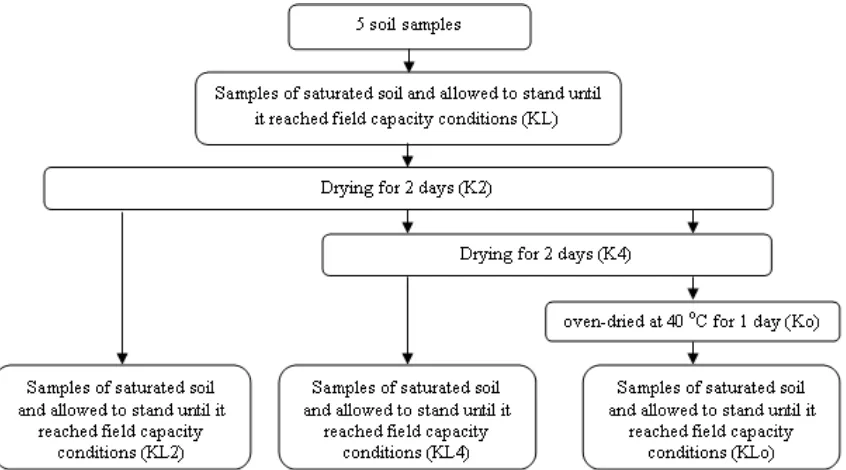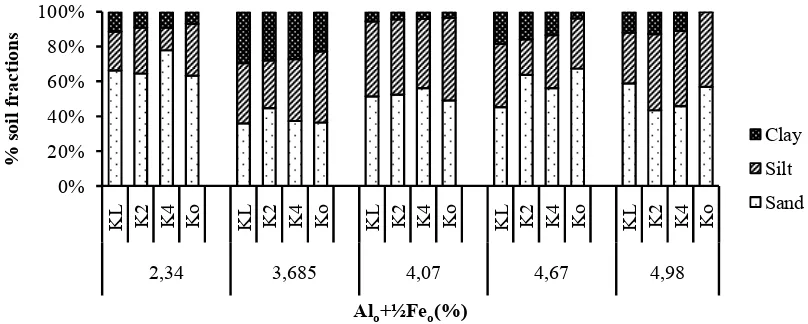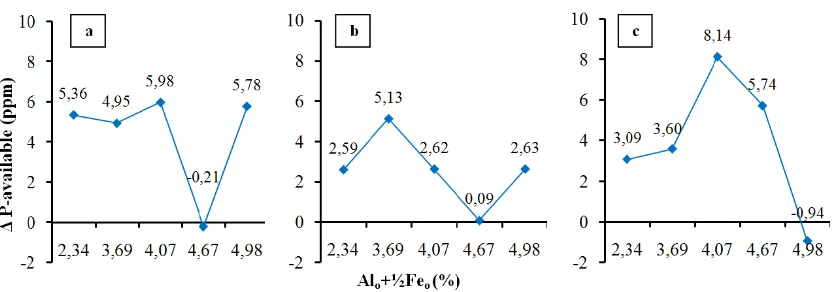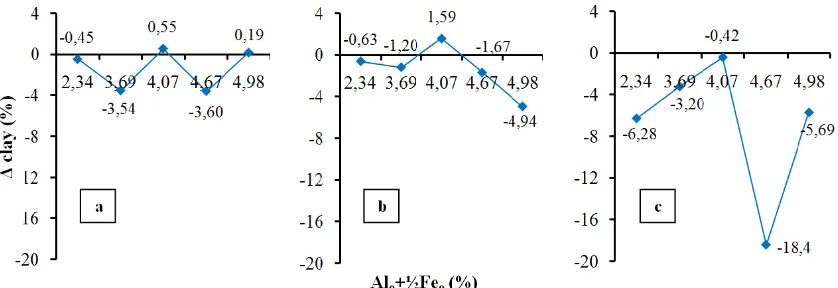ISSN: 2339-076X, Volume 3, Number 1 (October 2015): 439 - 446
DOI:10.15243/jdmlm.2015.031.439
Research Article
The changes of soil physical and chemical properties of Andisols as
affected by drying and rewetting processes
A. Rahayu
1*, S.R. Utami
2, S. Prijono
21
Postgraduate Programme, Faculty of Agriculture, Brawijaya University, Jl. Veteran, Malang 65145, Indonesia
2
Department of Soil Science, Faculty of Agriculture, Brawijaya University, Jl. Veteran, Malang 65145, Indonesia
* corresponding author: [email protected]
Abstract
:Soils from a toposequence in northern slope of Mt. Kawi, Malang were sampled to study the effect of amorphous content on the irreversible drying properties of the soils. Water, clay, organic-C, and available P contents were measured at field capacity (KL), after air-drying for 2 days (K2) , air-drying for 4 days (K4), oven-drying at 40 °C for 1 day (Ko), as well as after rewetting K2 (KL2); K4 (KL4), and Ko (KLo). The results showed that water, clay, organic-C, and available P contents changed after drying and rewetting processes. Drying process decreased clay content but increased available P content. Clay and water content of the rewetted samples, especially after oven-drying (KLo) were lower than at initial field capacity (KL), as indication of irreversible properties. In contrast, available P and organic-C content were higher after drying-rewetting processes. Variation of water, clay, organic-C, and available P contents after drying-rewetting processes were significantly affected by respected properties at initial field capacity. These properties tended to change in accordance to Alo+½Feo content. The effect of Alo+½Feo content,however was statisticaly detected only on the water content at KLo (rewetted after oven-dried) and on organic C content at KL2 and KL4 (rewetted after air-dried for 2 and 4 days).
Keywords :Andisols, irreversible drying, amorphous materials, soil properties
Introduction
Soil management requires a deep understanding on soil properties and characteristics that possibly affect crop growth. The northern slope of Mount Kawi-Butak is dominated by Andisols, which have unique-physical properties due to a high content of amorphous mineral (Nita et al., 2015). The amorphous minerals play significant role in determining soil physical and chemical properties (Van Ranst et al., 2002; Qafoku et al., 2004).
Andisols commonly have irreversible characters after drying. This character is suspected to create some problems during analysis at the laboratory. Drying of soil samples prior to laboratory analysis will certainly change soil properties, which are going to be measured. Variation of soil moisture due to different drying intensities will eventually affect quality of the results.
Many studies have been conducted on the effect of drying duration on soil properties. Most of these studies (Seguel and Horn, 2006; Khan et
al., 2007; Blackwell et al., 2009) dealt with the irreversible properties of Andisols only as the effect of drying. No studies, however, examined whether these properties are irreversible if the soil samples are rewetted to the initial moisture condition. Therefore, this study was aimed to elucidate the effect of drying and rewetting processes on the changes of soil properties, and their relationships with amorphous material contents.
Materials and Methods
Five soil samples, classified as Humic Udivitrands (Putra et al, 2015), were collected from a toposequence at the northern slope of Mt. Kawi, Pujon, Malang. Soil samples were taken at field capacity (KL), Since the content of Alo+½Feo(Al
and Fe, extracted from 1 M ammonium oxalate) indicated the occurence of amorphous minerals, soils with varying Alo+½Feocontent were selected
A5=5%) for this study. Data of Alo+½Feocontent
were taken from previous study (Nita et al., 2015). Experiment on the irreversible drying properties comprised of two processes, i.e. drying and rewetting the soil samples. The drying process comprised of three different levels of
drying, i.e. drying for 2 days (K2), 4 days (K4), and oven-drying at 40 oC for 1 day (Ko). Then, soil samples (K2, K4, and Ko) were rewetted to the field capacity condition (KL2, KL4, and KLo, respectively). Schematically, drying and rewetting processes are presented in Figure 1.
Figure 1. Scheme of drying and rewetting process
Water content, organic-C, total-N, available P and water-dispersible clay contents were analyzed on each condition (KL, K2, K4, Ko, KL2, KL4, dan KLo) to study the change of soil properties after drying and rewetting. Differences in soil properties between K2, K4, Ko, and KL showed the effect of drying. Whereas the irreversible drying properties were reflected by the difference between KL2, KL4, KLo, and KL. Then, such changes of soil properties were correlated with the Alo+½Feocontent.
Results and Discussion
Effect of drying on changes of the soil properties
Available P content
The drying process has changed the value of available P content of each soil samples. The drying from KL to K4 (4 days drying) increased the available P contents in A2, A3, and A5 soils, but the values decreased again after oven-dried (Ko). The content of available- P in Ko was higher than that of KL (Figure 2). In general, available P content in soil tended to increase during the drying from 2 to 4 days. This was thought that such drying affected the behaviours
of the amorphous materials. The drying process from 2 to 4 days loosened the bond between the amorphous materials and P, so that available P increased. The increase of available P might be due to the release of P which was initialy fixed by the amorphous minerals (Ethan, 2015). The prolonged periods of drought accelerate mineral breakdown producing a higher degree of crystallinity of ferric hydroxides (oxy) and a decrease in binding phosphorus (Baldwin, 1996).
and oxide hydrate Al and Fe. (Nuryani et al., 2000). Meanwhile, a decrease content of available P in Ko was probably due to P-reprecipitation,
which was previously released from the amorphous mineral fixation.
Figure 2. Effect of soil drying on available P content
Clay content
The clay content kept decreasing along with duration of drying (Figure 3). The decrease of clay content was followed by the increase of silt and/or sand contents. Drying process caused the clay grains bounded together and formed larger
particles, i.e. pseudosands and pseudosilts. In some soil samples, the drying decreased silt content, followed by the increasing sand content. This indicated that pseudosand was formed not only from clay particles, but also from the silt particles.
Figure 3. Effect of soil drying on clay, silt and sand contents
Irreversible drying properties
Soil water content
In this study, the irreversible drying properties on the soil water content was shown by the negative value of the difference between water content measured on dried and rewetted samples in
comparison with the initial field capacity (KL). This means that after the soil was dried and rewetted, the water level was lower than the initial KL condition. The results of water content measurement are presented in Figure 4. The irreversible drying properties were shown in A1, A2, A4, and A5 samples. This irreversible water content (KL2, KL4, and KLo) obviously occurred 0
2,34 3,685 4,07 4,67 4,98
in A5 soil having high content of Alo+½Feo.
Water content in A5 soil was in the order of KLo<KL4<KL2, meaning that water content
could not reach KL condition even it was rewetted with the same amount of water.
Figure 4. Soil water content after being dried for 2 days (a), 4 days (b) and oven-dried at 40 °C (c) and rewetted, in comparison to the initial field capacity. Notes: negative or positive values mean water content at the condition a, b, and c, respectively lower or higher than the initial field capacity condition.
The drying process caused air to captivate the soil particles, so that when soil sample rewetted, air pore blockage prevented the entry of water into the soil pores. Besides, drying process could decrease the surface charge of amorphous materials which in return affecting water holding capacity of the soil. The stepwise regression analysis on the Alo+½Feo, C-organic, clay, and
soil water content (at KL) toward the irreversible drying properties of the water content (Table 1) showed that the soil water content under field capacity condition had the greatest effect on the irreversible drying properties in KL2 (rewetted after air-dried for 2 days) and Klo (oven-dried at 40 °C for 1 day).
Table 1. Results of the stepwise regression analysis on the irreversible drying properties of water content
Step Water content
KL2-KL KL4-KL KLo-KL
1 y = -0.623 - 1.121x4 y = 0.229 - 0.393x4 y = 0.757 - 1.027x4
R2= 0.764 R2= 0.611 R2= 0.853
2 - y = 0.210 - 0.422x4+ 0.003x3 y = 0.363 - 0.776x4+ 0.051x1
R2= 0.755 R2= 0.940
3 - - y = 0.376 - 0.839x4+ 0.046 x1+ 0.004x3
R2= 0.989
Notes : y = irreversible drying properties of soil water content, x1= content of Alo+½Feo, x2= organic-C, x3= soil
clay content, x4= soil water content of the field capacity
Water content at field capacity contributed 76%; 61%; and 85% respectively to the water contents of KL2 (rewetted after air-dried for 2 days), KL4 (rewetted after air-dried for 4 days), and KLo (rewetted after-dried 40 °C for 1 day). At two days drying process, 24% variation of irreversible drying properties was not significantly influenced by the content of Alo+½Feo, % organic-C, and %
clay. On 4 days drying, effect of the initial water content (KA) was followed by % clay, which indicated an increase in the value of R2 (from 61 to 76 %), while 24% variations was determined by other factors. On the oven-dried at 40 °C for 1 day, 99% variation of irreversible drying
properties of water content could be explained by variation of initial water content (85%), Alo+½Feo
content (9%), and % clay (14%). In general, soil containing high amorphous materials (Alo+½Feo),
affected (<10%). the irreversible drying properies of water content only after oven-drying process. This suggested that the 2 and 4 days air-drying did not significantly affect the amorphous minerals.
Organic-C content
Data presented in Figure 5 show that organic-C content of the KL2 and KL4 conditions are generally higher than C-organic content at the initial field capacity. The drying process for 2 and 4 days was not able to destroy the bond between organic materials and amorphous clay minerals, so that organic-C content tended to be similar with the field capacity. The increasing content of organic-C in the soil after rewetting process was presumed to be related to C-mineralization process by microbe in the soil. The stepwise regression analysis on the Alo+½Feo, C-organic,
and clay content toward the irreversible drying properties of the water content is shown in Table 2. A number of microorganisms are known to survive during the drying, due to the accumulation of cytoplasmic role as osmoregulator in the cell (Halverson, 2000). This was supported by Franzluebbers et al. (1994) who stated that rewetting of the dry soil would change C, which showed the microorganism’s activities in the soil after rewetting process. According to Baldwin and Mitchell (2000), the repetition of drying and wetting over longer time periods will allow bacterial to reproduce rapidly when favorable environmental conditions and can outlive unfavorable conditions by producing a resting stages.
Figure 5. Content of organic-C after being dried for 2 days (a), 4 days (b), and oven-dried at 40 °C (c), and rewetted, in comparison with the initial field capacity. Notes: negative or positive values mean % organic-C at condition a, b, and c, respectively, were smaller or greater, in comparison with the initial field capacity.
The consistent pattern was found on A5, soil sample containing the highest % Alo+½Feo.
Drying for 2 days and rewetting did not change the content of organic-C. However, after air-drying for 4 days, organic-C has reduced drastically even though the soil was rewetted to initial condition. This meant that on A5, the irreversible drying properties of organic-C have occurred after the soil has been air-dried for 4 days.
The irreversible drying properties of organic-C in this study generally occurred after the soil was dried at 40 °C or 1 day. On this condition, it was presumed that drying under high temperature would destroy the bond of organic-C compounds in the soil, so that C would be released in the form of gas. Such rewetting would not be able to restore organic-C content in the soil as at the field capacity.
Table 2. Results of the stepwise regression analysis on the irreversible drying properties of C-organic content
Stage Organic-C content
KL2-KL KL4-KL KLo-KL
1 y = 0.961 – 0.171x1 y = 1.549 – 0.345x1
-R2= 0.651 R2= 0.624
2 y = 1.118 – 0.171x1–0.010x2 -
Notes : y = irreversible drying properties of C, x1= content of Alo+½Feo, x2= soil clay content, x3= organic-C of the
field capacity
Available P content
The results showed that drying and rewetting processes increased P-available in the soil. Such drying might destroyed the bond between amorphous minerals and P in the soil, so that P would be released and consequently increase available P content in the soil. Meanwhile, rewetting could significantly dissolve the released
P, which was intially not soluble, and became soluble. This result was similiar to that of Schönbrunner et al. (2012) that the repetition of drying and wetting back process causes the release of phosphorus, where the rate of drying is a major determinant of controlling the release of phosphorus during rewetting process.
Figure 6. P-available in the soil after being dried for 2 days (a), 4 days (b), and oven-dried at 40 °C (c), as well as rewetted, in comparison with KL condition. Notes: negative or positive values meant water levels at condition a, b, and c, respectively, were smaller or greater, in comparison with the initial field capacity.
The stepwise regression analysis showed that after drying for 2 and 4 days, the content of Alo+½Feo,
C-organic, clay, and P-available in the soil at the field capacity, had no significant effect on the irreversible drying properties of P-available in the soil. Whereas on the samples which were oven-dried at 40 °C for a day, only P-available at the initial field capacity, had significant effect on the irreversible drying properties of P-available.
Andisols may contain considerable amount of total P, but P-ion is strongly bound by amorphous minerals, resulting in a low amount available for plants. Drying process of the soil would break the bond between phosphate ions and amorphous clay minerals, so that the measured P will be released and become available for plants. The rewetting process could not restore the reactivity of the amorphous clay minerals. The increase of P-availability in the soil after submersion can be the results of reduction of FePO4.2H2O to Fe(PO4)2.8H2O, desorption as a
result of reduction Fe3+ to Fe2+, hydrolisis of Fe(PO4) and AlPO4 on acid soil, release of
occluded-P, and /or anion exchange (Ethan, 2015).
Clay content
The previous drying process caused the clay particles formed larger size of soil particles, i.e. pseudosilt and pseudosand, so that the clay particles would decrease. Figure 7 showed that all soil samples had inconsistent values during the rewetting process, but in general, such rewetting could not restore the decreased clay particles after the soil samples were drying. It was presumed that the pseudosilts and pseudosands formed during drying process, were difficult to re-dispers after rewetting samples following drying process.
Results of the stepwise regression analysis (Table 3) on the influential factors (content of Alo+½Feo and clay percentage of the field
soil. Meanwhile, during the drying for 4 days and oven-drying at 40 °C for a day, the tested variables, both solely or simultaneously, have no
significant effect on the irreversible drying properties of clay in the soil.
Figure 7. Percentage of clay particles after being dried for 2 days (a), 4 days (b), and oven-dried at 40 °C (c), as well as rewetted, in comparison with KL condition. Notes: negative or positive values meant water levels at condition a, b, and c, respectively, were smaller or greater, in comparison with the initial field capacity condition.
Table 3. Results of the stepwise regression analysis on irreversible drying properties for clay content
Stage Clay content
KL2-KL KL4-KL KLo-KL
1 y = 1.665 – 0.197x2 -
-R2= 0.772
Notes: y = irreversible drying properties of clay, x1= content of Alo+½Feo, x2= clay content of the field
capacity
Conclusion
Water, clay, organic-C, and available P contents changed after drying and rewetting process. Drying process decreased clay content but increased available P content. Rewetting process after air-drying was unable to restore water content and % clay at initial field capacity (KL). In contrast, available P and organic C contents were higher after drying-rewetting process.
Variation of water, clay, organic-C, and available P contents after drying-rewetting process was significantly affected by respected properties at initial field capacity. These properties tended to change in accordance to Alo+½Feo content. The effect of Alo+½Feo
content, however was statisticaly detected only on the water content at KL4 (rewetted after 4 days air-drying) and on organic C content at KL2 and KL4 (rewetted after air drying for 2 and 4 days).
Acknowledgements
The data presented in this paper were part of the Master Thesis of the first author, at Soil and Water
Management Study Program, at Faculty of Agriculture, UB. Special thanks are due to Directorate General of Higher Education in Indonesia for scholarship grant under the frame of MSc-Fast Track Programme, 2012-2014. Grateful thank also goes to the staffs of Bendosari village, Pujon, Malang Regency for their kind help in collecting soil samples.
References
Baldwin, D.S. 1996. Effects of exposure to air and subsequent drying on the phosphate sorption characteristics of sediments from a eutrophic reservoir. Limnology Oceanography. 41(8):1725– 1732.
Baldwin, D.S. and Mitchell, A.M. 2000. The effects of drying and re-flooding on the sediment and soil nutrient dynamics of lowland river-floodplain systems: a synthesis. Regulated River-Research and Management. 16(5):457–467.
Blackwell, M.S.A., Brookes, P.C., Martines, de la F., Murray, P.J., Snars, K.E., J.K. Williams,J.K. and Haygarth, P.M. 2009. Effects of soil drying and rewetting on forms and quantities of phosphorus in leachate.Biology and Fertility of Soils. 45(6):635-643.
Innovative Science, Engineering & Technology 2 (4) : 414-420.
Franzluebbers, K., Weaver, R.W., Juo, S.R. and Franzluebbers, A.J. 1994. Carbon and nitrogen mineralization from cowpea plants part decomposing in moist and repeatedly dried and wetted soil. Soil Biology and Biochemistry. 26:1379-1387.
Halverson, L.J., Jones, T.M. and Firestone, M.K. 2000. Release of intracellular solutes by four soil bacteria exposed to dillution stress.Soil Science Society of America Journal64:1630–1637.
Khan, H., Matsue, N. and Henmi, T. 2007. Adsorption of water on nano-ball allophane as affected by dry grinding. International Journal of Soil Science2: 247-257.
Nita, I. Utami, S.R. and Kusuma, Z. 2015. The effect of Al, Si and Fe contents (selective dissolution) on soil physical properties at the northern slope of Mt. Kawi. Journal of Degraded and Mining Lands Management2(3): 319-326.
Nuryani, S., Handayani, S. dan Maas, A. 2000. Meningkatkan efisiensi pemupukan p dengan bahan organik pada Andisol. Jurnal Ilmu Tanah dan Lingkungan2 (2): 7-12.
Peniwiratri, L., Shiddieq, D. dan Syukur, A. 2001. Peranan asam-asam organik berberat molekul rendah terhadap ketersediaan fosfat Andisol. Jurnal Tanah dan Air2(1):15-21.
Putra, A.N., Sudarto, and Rayes, M.L. 2015. The characteristics and genesis of volcanic ash soils at the northern slope toposequence of Kawi Mountain in Malang Regency. Journal of Degraded and mining Lands Management2 (4): 383-390.
Qafoku, N. P., Van Ranst, E. Noble, A. and Baert, G. 2004. Variable charge soils, their mineralogy, chemistry and management. Advances in
Agronomy84:157-213.
Schönbrunner, I.M., Preiner, S. and Hein, T. 2012. Impact of drying and re-flooding of sediment on phosphorus dynamics of river-floodplain systems. The Science of the Total Environment 432(10): 329-337.
Seguel, O. and Horn, R. 2006. Structure properties and pore dynamics in aggregate beds due to wetting-drying cycles. Journal of Plant Nutrition Soil Science169: 221-232.
Van Ranst, E., Utami, S.R and Shamshuddin, J. 2002. Andisols on volcanic ash from Java island, Indonesia: Physico-chemical properties and classification.Soil Science167(1): 68-79.





